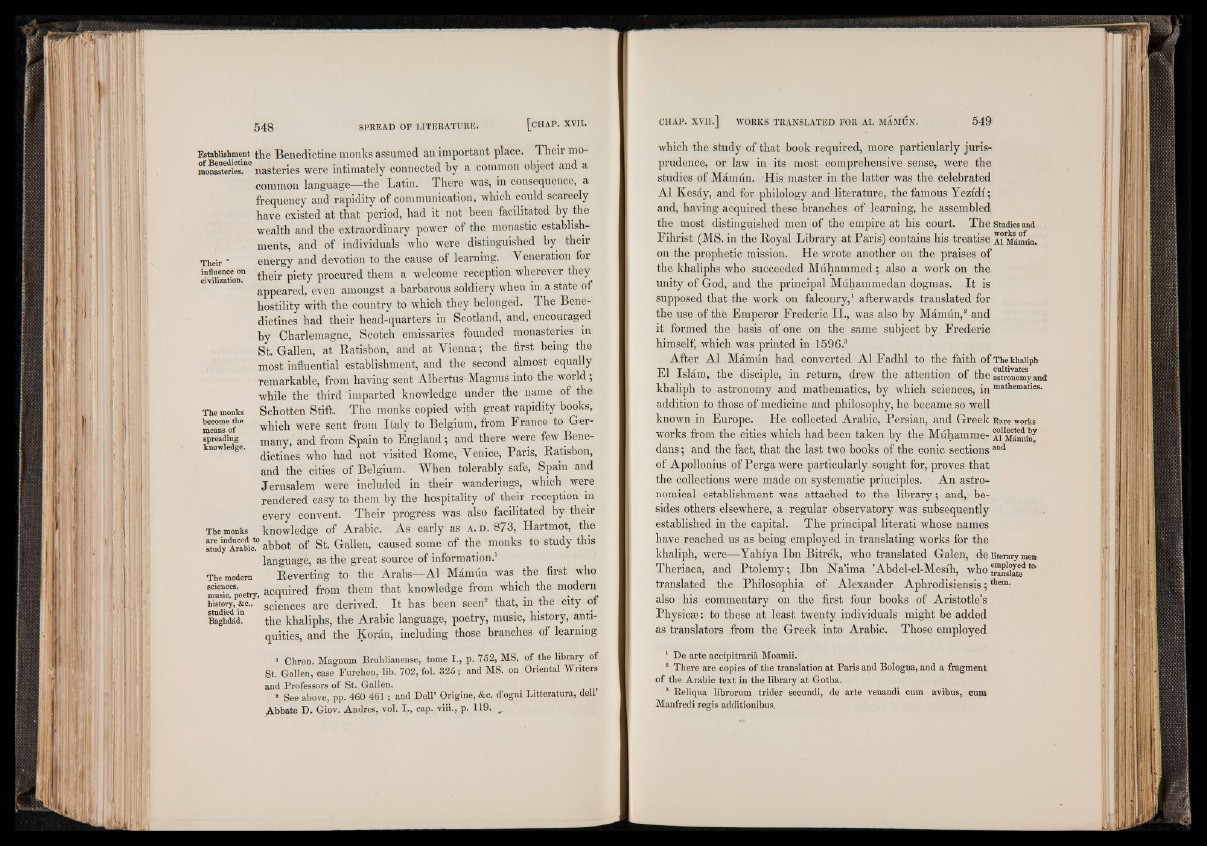
Establishment the Benedictine monks assumed an important place. Their mo-
monasteries'.116 nasteries were intimately connected by a common object and a
common language—the Latin. There was, in consequence, a
frequency and rapidity of communication, which could scarcely
have existed at that period, had it not been facilitated by the
wealth and the extraordinary power of the monastic establishments,
and of individuals who were distinguished by their
Their * energy and devotion to the cause of learning. Vénération for
d v S f o m their piety procured them a welcome reception wherever they
appeared, even amongst a barbarous soldiery when in a state of
hostility with the country to which they belonged. The Benedictines
had their head-quarters in Scotland, and, encouraged
by Charlemagne, Scotch emissaries founded monasteries in
St. Gallen, at Ratisbon, and at Vienna; the first being the
most influential establishment, and the second almost equally
remarkable, from having sent Albertus Magnus into the world;
while the third imparted knowledge under the name of the
The monks Schotten Stitt. The monks copied with great rapidity books,
meamTof16 which were sent from Italy to Belgium, from France to Ger- JUCtUlS Ui * _ n T)
spreading many, and from Spain to England 5 and there were tew x>ene
e S dictines who had not visited Rome, Venice, Paris, Ratisbon,
and the cities of Belgium. When tolerably safe, Spain and
Jerusalem were included in their wanderings, which were
rendered easy to them by the hospitality of their reception in
every convent. Their progress was also facilitated by their
The monks knowledge of Arabic. As early as a . d . 873, Hartmot, the
smdy S i c . 0 abbot of St. Gallen, caused some of the monks to study this
language, as the great source of information.1
The modem Reverting to the Arabs—A1 Mamun was the first who
music^poetry, acquired from them that knowledge from which the modern
history, &c., sciences are derived. It has been seen2 that, in the city of
Baghdad" the khaliphs, the Arabic language, poetry, music, history, antiquities,
and the Koran, including those branches of learning
1 Chron. Magnum Bruhlianense, tome I ., p. 752, MS. of the library of
St. Gallen, case Furchen, lib. 702, fol. 325 ; and MS. on Oriental Writers
and Professors of St. Gallen. _
8 See above, pp. 460 461 ; and Dell’ Origine, &c. d’ogni Litteratura, dell
Abbate D. Giov. Andres, vol. I., cap. viii., p. 119. _
which the study of that book required, more particularly jurisprudence,
or law in its most comprehensive sense, were the
studies of Mamun. His master in the latter was the celebrated
Al Kesay, and for philology and literature, the famous Yezidi ;
and, having acquired these branches of learning, he assembled
the most distinguished men of the empire at his court. The studies and
Fihrist (MS. in the Royal Library at Paris) contains his treatise AiMàmdn.
on the prophetic mission. He wrote another on the praises of
the khaliphs who succeeded Muhammed ; also a work on the
unity of God, and the principal Muhammedan dogmas. It is
supposed that the work on falconry,1 afterwards translated for
the use of thè Emperor Frederic II., was also by Mamun,2 and
it formed the basis of one on the same subject by Frederic
himself which was printed in 1596.3
After Al Mamun had converted Al Fadhl to the faith of The khaliph
El Islam, the disciple, in return, drew the attention of the astronomy and
khaliph to astronomy and mathematics, by which sciences, in mathematics-
addition to those of medicine and philosophy, he became so well
known in Europe. He collected Arabic, Persian, and Greek Rare works
works from the cities which had been taken by the Muhamme- Ai Màmùny
dans ; and the fact, that the last two books of the conic sections and
of Apollonius of Perga were particularly, sought for, proves that
the collections were made on systematic principles. An astronomical
establishment was attached to the library; and, besides
others elsewhere, a regular observatory was subsequently
established in the capital. The principal literati whose names
have reached us as being employed in translating works for the
khaliph, were—Yahiya Ibn Bitrék, who translated Galen, de literary men
Theriaca, and Ptolemy; Ibn Na’ima ’Abdel-el-Mesih, whoSsiate*to
translated the Philosophia of Alexander Aphrodisiensis ; them-
also his commentary on the first four books of Aristotle’s
Physic®: to these at least twenty individuals might be added
as translators from the Greek into Arabic. Those employed
1 De arte accipitrarià Moamii.
a There are copies of the translation a t Paris and Bologna, and a fragment
of the Arabic text in the library at Gotha.
8 Reliqua librorum trider secundi, de arte venandi cum avibus, cum
Manfredi regis additionibus.